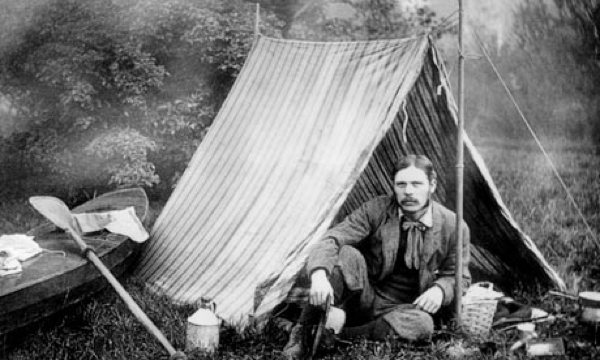Once upon a time, camping wasn’t a recreational activity (shock!). It was a necessity – a cheap and simple way to be on the move whilst transporting goods across the country, for hunters and fisherman following animals, or a way for armies to base themselves. And of course, for nomadic communities, camping has been a way of life for centuries. This is not to say that people no longer camp for these reasons, but it was not until the late 19th and early 20th centuries that recreational camping took on a life of its own and began its roots as the leisure activity we know today.

Early tents were heavy. In biblical times, there is evidence of tents made from oiled animal hides, including dolphin skins! By the 1800s, animal skins were still used, but alternatives included weighty canvas and waxed fabrics that were difficult and time consuming to erect.
The trend for pleasure boating had become quite fashionable in the late 19th century meant people could easily carry their heavy tents from point to point down whatever river they boated along, but it was difficult to transport such weights on one’s back or on smaller vehicles.
The Lightweight Revolution
This really began in the mid to late 19th century when Macintosh developed their rubberised silk jackets which weighed in at just over 5oz. Silk was becoming a popular choice for tent material as expeditioners looked for ways to save on weight.
The Travelling Tailor
Funnily enough, the first person to popularise recreational camping in the UK was a travelling tailor, named Thomas Hiram Holding. Holding’s passion for camping took hold when in 1853 at the age of 9, he went travelling across the North American prairies with his parents as part of a wagon train. As an adult, upon returning to the UK, Holding made several trips including a canoe and camping trip in the Highlands, and a cycling and camping tour across Ireland. Travelling by bike especially, necessitated tents that were lighter in weight and easy to transport. In July 1987, before Holding set off to Ireland, he designed a small, lightweight tent that suited his mode of transportation. Later, in 1899, Holding put together the ‘Phantom Kit’ for those keen to follow in his cycling and camping footsteps (or tire marks?). The kit is touted as a key point of the Lightweight Revolution and included;
A silk tent (less than 1lb)
15 bamboo poles (less than 1lb)
A down quilt weight (1lb and 8oz)
A mini primus pressurized burner that could be clipped onto the bike (less than 6lb)
Under 10 lb in total – not bad!
It was after his tour of the Emerald Isle that he wrote a book titled Cycle and Camp in Connemara encouraging readers with similar interests to get in touch. The book garnered enough interest for the first camping group to materialise in 1901. Then named the Association of Cycle Campers, this was the Camping and Caravanning Club in its original form – six men pitching up in an orchard in Berkshire! By 1906, however, the club had grown into the hundreds and the first permanent camping site was set up in Weybridge.
The early 80s welcomed with open arms the first lightweight fabric boots which waved farewell to extremely heavy leather footwear. And by the mid-80s, wool and tweed had all but gone, only to be replaced by microfibre and Pertex (used to make those hideous, shiny shell windbreakers that can, on occasion, actually look quite cool).
In 1983, The Camping and Caravanning Club had been christened with the name it goes by today. With memberships breaching 200,000 in 1991, thank goodness for the lighter tents the industry was now producing – otherwise imagine the collective weight of everyone’s rucksacks …
In 2013, The Camping and Caravanning Club welcomed Julia Bradbury as their president.
A huge fan of camping, caravanning and walking, we can also confirm Julia is a lover of lightweight gear which she says makes the outdoors that much more accessible. The development of lightweight outdoor gear has been reflected in the growing number of members of the Club.
Gone are the days of lugging canvas tents around by boat, replaced by the featherlight materials used by the likes of Outwell. As people can more easily transport their tents, of course it was inevitable everyone would want to get outside and camp!
Farewell to the heavy, itchy, clammy, woollen shirts and jumpers saving campers from hypothermia, making way for the second-skin style clothing that do the same job in a fraction of the weight. Julia’s go to brands for clothing are Ronhill and Rab with their breathable and stylish designs.
We’ve said goodbye to trekking up mountains with what may as well be bricks on our feet. Even the first Gore Tex shoes were pretty hefty! But all is well as we have said hello to the bouncy shoes brought to us by Salomon, Columbia and many more, making it so much easier to explore the great outdoors.

